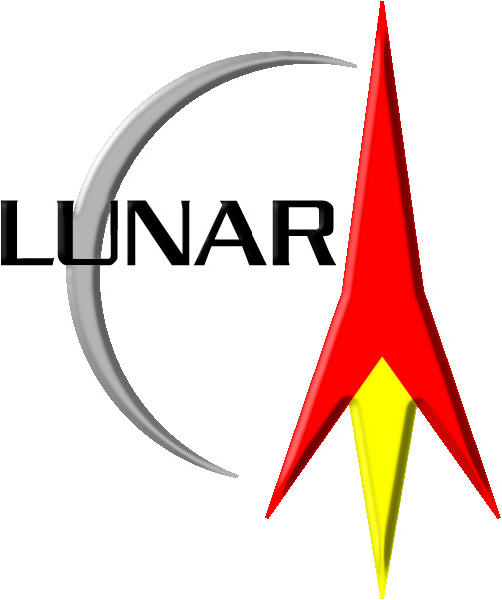 LUNAR’clips
2004
Volume 11, Number 2
LUNAR’clips
2004
Volume 11, Number 2
 LUNAR’clips
2004
Volume 11, Number 2
LUNAR’clips
2004
Volume 11, Number 2
Livermore Unit of the National Association of Rocketry March/April 2004
Copyright © 2004 by LUNAR, All rights reserved.
The plan is to launch the craft from an ocean-going barge at sea, and once the barge reaches the planned launch location the rocket flame deflector, launch guide and rocket are raised to a vertical position. Then the fuel and oxidizer (kerosene/LOX) are loaded into their respective tanks, and the pilot and passengers are loaded into the capsule. When seas and winds are calm enough and all systems are GO, the rocket fires. After rocket engine cutoff, the capsule is in freefall until well after it passes apogee (approximately 67 miles altitude). When the capsule reaches 30 thousand feet altitude on its descent, a parachute is released and begins to slow the capsule's fall. The capsule will be tracked by GPS, and is planned to land in the ocean 10 miles from the launch site, where the capsule and three-person crew will be recovered almost immediately.
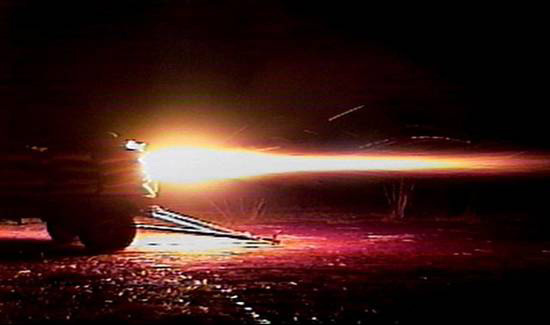
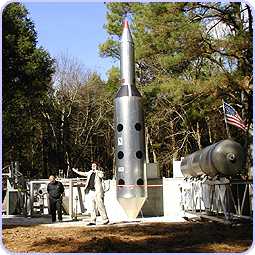
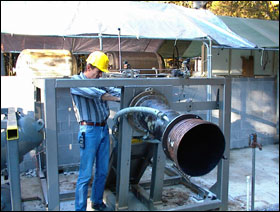
The 43 ft high launch vehicle uses 2 LOX-Kerosene regeneratively cooled engines that are pressure-fed and lightweight, with no rotating parts or expensive turbo-pumps. Don Robinson, VicePresident of HARC notes, "HARC rocket motor design engineers have redesigned the Liberator's totally reusable escape tower motor. We are excited about this new liquid bi-propellant motor." HARC engineers determined that the reliability was too low and the reload cost was too large for hybrid motors based on nitrous oxide (N2O) or laughing gas, as an oxidizer, and hydroxy-terminated polybutadiene (HTPB), or rubber, as the fuel. The first test firing of the new liquid bi-propellant motor was planned for late April at the Orion Propulsion test facilities near Huntsville, Alabama.
HARC's Website is at www.harcspace.com

IL Aerospace Technologies (ILAT) is based in Zichron Ya'akov, Israel, and is led by Dov Chartarifsky. Recently it has unveiled its new X Prize competition vehicle design now called "Negev" (formerly named Negev-5). Aside from the name, the vehicle's configuration has gone through several design iterations in the last few months. These modifications originated from a fresh set of innovative concepts derived from ILAT's recently formed technical team and advisory committee.
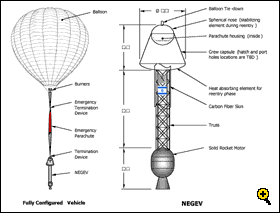
The Negev will be launched from ground level using a helium balloon as a first stage. This unconventional approach allows the vehicle to hitchhike a free ride to its intended rocket launch altitude of 10 Km (32,808 feet) above sea level, and overcome most of the atmospheric drag while saving precious fuel. This high-altitude launch concept makes it possible to design a smaller, lighter, simpler, and more efficient vehicle, hence satisfying the criterion for practical low-cost space access.
Once the altitude for rocket ignition is reached, the vehicle will be detached from the balloon initiating the staging process. The vehicle will drop for 3 to 5 seconds before the solid rocket motor ignites, creating a negative velocity of 50m/s. At the same time, the balloon will immediately sense the sudden ballast change and spring upwards, separating itself away from the vehicle to a safe distance. The on-board computer will control the firing of the 77.8 kN (17,500 lbf) solid rocket motor. The burn will last about 96 seconds at around 78% thrust, accelerating the vehicle to Mach 3.54 (1165.5 m/s). The altitude at burnout will be 49.6 Km (162,730 ft), while the G-force applied to the passengers will reach a maximum of 4.3 prior to burnout. After engine cut-off, the vehicle will continue to cruise pass the 100 Km (328,084 ft) mark where the crew will begin to experience weightlessness conditions for about 4 minutes. At approximately 120 Km (393,701 ft), all forward inertia will be depleted and the vehicle will start to free-fall back to earth.
The attitude of the vehicle will remain the identical to the one during the ascent phase. At an altitude higher than 70 Km (229,659 ft), the nose sphere will detach from the capsule but will remain connected by a cable, thus serving as a stabilizing element during the reentry phase. The maximum deceleration force will peek at ~5.81 G's at 23.6 Km (77,428 ft) into the decent. At an altitude of 5 Km (16,404 ft), at a velocity of around 85m/sec (190 mph), the parachute sequence will start by pyrotechnically deploying both drogue and main chutes sequentially. This altitude is high enough to allow redundant sequences in case of primary system failure. With the main chute fully open, the vehicle will slow down to a mere 7 m/sec before splashing down to the sea.
They are dedicating this endeavor in honor of our first Israeli astronaut, Col. Ilan Ramon (1954-2003) who died a hero along with the rest of the STS-107 crew in the relentless pursuance of space exploration.
Their Website is at www.ilat.net
Return to IndexAll content is the responsibility of LUNAR.
If you have comments or suggestions regarding these web pages,
please contact the 
Copyright © 1992 - 2025 LUNAR